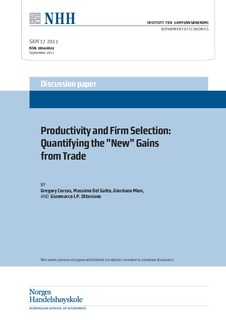| dc.contributor.author | Corcos, Gregory | |
| dc.contributor.author | Del Gatto, Massimo | |
| dc.contributor.author | Mion, Giordano | |
| dc.contributor.author | Ottaviano, Gianmarco I. P. | |
| dc.date.accessioned | 2012-03-13T12:15:50Z | |
| dc.date.available | 2012-03-13T12:15:50Z | |
| dc.date.issued | 2011-09 | |
| dc.identifier.issn | 0804-6824 | |
| dc.identifier.uri | http://hdl.handle.net/11250/163354 | |
| dc.description.abstract | We discuss how standard computable equilibrium models of trade policy can be enriched with selection effects. This is achieved by estimating and simulating a partial equilibrium model that accounts
for a number of real world effects of trade liberalisation: richer availability of product varieties; tougher
competition and weaker market power of firms; better exploitation of economies of scale; and, of course,
efficiency gains via firms selection. The model is estimated on EU data and then simulated in counter-factual scenarios. Gains from trade are much larger in the presence of selection effects with substantial
variability across countries and sectors. | no_NO |
| dc.language.iso | eng | no_NO |
| dc.publisher | Norwegian School of Economics, Department of Economics | no_NO |
| dc.relation.ispartofseries | Discussion Papers;17/2011 | |
| dc.title | Productivity and Firm Selection: Quantifying the "New" Gains from Trade | no_NO |
| dc.type | Working paper | no_NO |
| dc.subject.nsi | VDP::Social science: 200::Economics: 210::Economics: 212 | no_NO |
